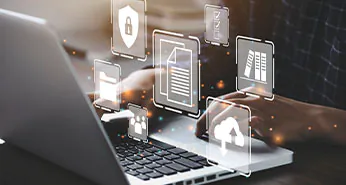Table of Contents
What is Predictive Data Analytics?
Within the IT industry, staying abreast of evolving trends is important for organizational growth and success. Data analytics has emerged as a transformative force, enabling IT businesses to harness the power of information for enhanced performance and strategic decision-making. Predicting Trends in the IT Industry is a crucial task that helps businesses stay ahead of the competition and make informed decisions. By leveraging advanced technologies such as artificial intelligence (AI) and machine learning (ML), organizations can gain valuable insights from large amounts of data.
Book a demo to experience the meaningful insights we derive from data through our analytical tools and platform capabilities.
Request a DemoHow does predictive Data analytics work in the IT Industry?
These techniques are an assortment of business intelligence, online analytical processing (OLAP), and other advanced applications with a much broader focus. These services have expansive organizational benefits that help businesses drive revenue, improve operational efficiency, optimize customer experience, and develop effective marketing campaigns. Data analytics coupled with business intelligence and related advanced analytical services can work wonders in every industry, especially in the booming IT industry.
Predictive analytics is a powerful tool that leverages statistical models and machine learning algorithms to uncover patterns and relationships within data, enabling organizations to make informed decisions and predictions about future outcomes. The process of implementing predictive analytics involves several key steps:
Data Collection and Preparation
The foundation of predictive analytics lies in the availability of high-quality data. Data scientists gather relevant data from various sources, such as customer interactions, historical records, and real-time feeds. This data is then cleaned, transformed, and organized into a structured format suitable for analysis.
Feature Engineering
Feature engineering is the process of selecting and transforming relevant variables (features) from the raw data to create more informative and predictive inputs for the statistical models. Data scientists carefully choose and manipulate features to enhance the model’s ability to capture the underlying patterns and relationships in the data.
Model Selection and Training
Based on the problem at hand and the nature of the data, data scientists select appropriate statistical models or machine learning algorithms. These models are then trained on the prepared data, allowing them to learn from past patterns and relationships. The training process involves iteratively adjusting the model’s parameters to minimize the error between the predicted outcomes and the actual outcomes.
Model Evaluation and Validation
To ensure the accuracy and reliability of the predictive models, they are evaluated using various metrics and techniques. Data scientists split the data into training and testing sets, with the testing set being used to assess the model’s performance on unseen data. This process helps identify any potential overfitting or underfitting of the model.
Deployment and Monitoring
Once the predictive models have been developed and validated, they are deployed into production environments, where they can be used to generate predictions and insights. These insights are then integrated into decision-making processes, such as targeted marketing campaigns, fraud detection systems, or inventory optimization strategies. Continuous monitoring of the model’s performance is crucial to ensure that it remains accurate and relevant over time, as new data becomes available.
Predictive analytics has a wide range of applications across various industries, from healthcare to finance to retail. By leveraging the power of data and advanced statistical techniques, organizations can gain a competitive edge, make more informed decisions, and optimize their operations for better outcomes.
Experience the advantages firsthand by testing a customized complimentary pilot designed to address your specific requirements. Pilot studies are non-committal in nature.
Request a trial nowTop Predictive Data Analytics Tools and Trends in the IT Industry
SAP Analytics Cloud (SAC)
SAP Analytics Cloud is a powerful platform that integrates business intelligence, planning, and predictive analytics into a unified environment. It is particularly beneficial for enterprises that rely on SAP for managing logistics, supply chains, and inventory. By leveraging SAC, businesses can streamline their operations and make informed decisions based on comprehensive data insights.
Alteryx AI Platform
The Alteryx AI Platform is renowned for its collaborative features and automated data preparation capabilities. It offers visual tools that simplify predictive modeling and integrates seamlessly with machine learning platforms. This makes it an ideal choice for teams that need to work together on complex data projects, ensuring that both technical and non-technical users can contribute effectively.
H2O Driverless AI
H2O Driverless AI is designed to automate many aspects of predictive analytics, including feature engineering, model selection, and explainability. This platform is user-friendly enough for citizen data scientists while still offering advanced capabilities for experts. By automating many of the tedious tasks involved in predictive modeling, H2O Driverless AI helps teams focus on higher-level strategic decisions.
IBM Watson Studio
IBM Watson Studio provides a comprehensive suite of predictive analytics tools that support collaboration among data scientists and business users. It emphasizes responsible AI practices by incorporating features for explainable models, ensuring that decision-making processes are transparent and trustworthy. This platform is ideal for organizations seeking to leverage advanced predictive capabilities while maintaining ethical standards.
Microsoft Azure Machine Learning
Microsoft Azure Machine Learning offers a complete end-to-end solution for predictive analytics workflows. It integrates well with other Microsoft tools, such as Power BI, making it a seamless choice for businesses already invested in the Microsoft ecosystem. Azure ML supports the development, deployment, and management of machine learning models, providing a robust foundation for predictive analytics projects.
Dataiku
Dataiku is a versatile platform that supports both visual and code-based interfaces, catering to diverse teams working on machine learning and deployment. It is designed to facilitate collaboration among data scientists, engineers, and analysts, ensuring that predictive models are developed efficiently and effectively. Dataiku’s flexibility makes it suitable for a wide range of predictive analytics applications.
SAS Advanced Analytics
SAS Advanced Analytics is a robust enterprise-grade tool that provides extensive capabilities for statistical analysis and predictive modeling. It is designed to handle complex data sets and offers advanced features for data mining, forecasting, and optimization. SAS is particularly popular among organizations that require high-level statistical analysis and predictive insights.
Altair AI Studio (formerly RapidMiner)
Altair AI Studio, formerly known as RapidMiner, simplifies data preparation, modeling, and deployment with tools like Auto Model and Turbo Prep. It offers a user-friendly interface that automates many predictive analytics tasks, making it accessible to both beginners and experienced users. This platform is ideal for teams looking to streamline their predictive modeling processes.
TIBCO
TIBCO offers predictive analytics software with both free and premium options, catering to a wide range of users. It provides advanced tools for data integration, analytics, and visualization, making it suitable for businesses seeking to enhance their predictive capabilities without breaking the bank.
Sisense
Sisense is a powerful tool aimed at data scientists, integrating predictive analytics into dashboards to provide actionable insights. It supports the creation of interactive visualizations that help businesses make data-driven decisions. By embedding predictive models directly into dashboards, Sisense enables organizations to respond quickly to changing market conditions.
Key Predictive Analytics Trends
The IT industry is witnessing transformative trends in predictive analytics that are reshaping how businesses leverage data:
Real-Time Predictive Analytics
Real-time predictive analytics involves processing data streams from sources like IoT devices, sensors, and customer interactions to make instant predictions. This trend allows businesses to respond rapidly to changing conditions, improving operational efficiency and enabling timely decision-making. By leveraging real-time data, organizations can stay ahead of competitors and capitalize on emerging opportunities.
Advanced Machine Learning and Deep Learning
Advanced machine learning and deep learning algorithms are transforming predictive analytics by enabling more precise predictions from vast amounts of structured and unstructured data. Applications in image recognition, natural language processing (NLP), and autonomous systems are expanding predictive capabilities, allowing businesses to tackle complex challenges that were previously unsolvable.
Quantum Computing
Quantum computing is emerging as a revolutionary technology that drastically increases computational power. It has the potential to solve complex predictive problems in areas like climate risk analysis, financial market monitoring, and more. As quantum computing becomes more accessible, it is expected to significantly enhance predictive analytics capabilities across various industries.
Cloud-Based Predictive Analytics
Cloud-based predictive analytics platforms are evolving to offer scalable solutions for building prediction models, automating workflows, and integrating with other analytics tools. Hybrid cloud strategies are gaining traction as they allow businesses to balance sensitive on-premise data with scalable cloud resources. This flexibility is crucial for organizations seeking to optimize their predictive analytics infrastructure.
Edge Computing for Predictive Maintenance
Edge computing processes data closer to its source, reducing latency and bandwidth usage. This is particularly useful in IoT applications like predictive maintenance in industrial equipment or smart city traffic optimization. By analyzing data in real-time at the edge, businesses can respond quickly to potential issues, improving efficiency and reducing downtime.
Data Integration and Interoperability
Advanced platforms now support real-time ingestion of diverse data sources into unified repositories. Seamless integration enhances holistic insights across systems, allowing businesses to leverage all available data for predictive analytics. This trend is crucial for creating a comprehensive view of operations and making informed strategic decisions.
Responsible AI and Explainability
Tools are increasingly focusing on ethical AI practices by incorporating explainable models that ensure transparency in decision-making processes. Responsible AI practices are becoming essential as predictive analytics plays a more significant role in business operations. By providing clear insights into how predictions are made, organizations can build trust with stakeholders and maintain compliance with regulatory standards.
Get started with your complimentary trial today and delve into our platform without any obligations. Explore our wide range of customized, consumption-driven analytical solutions services built across the analytical maturity levels.
Start your trial nowModern Techniques and Data Analytics
Predictive analytics for decision-making is transforming industries by leveraging AI in predictive data analytics to provide deep insights into customer behavior prediction. Companies use predictive analytics case studies to showcase real-world applications, including sales forecasting with predictive analytics, which helps businesses make data-driven decisions. In healthcare, predictive analytics plays a crucial role in enhancing patient outcomes by predicting potential health risks. Additionally, it aids in risk management using predictive analytics, enabling organizations to mitigate future uncertainties. As future trends in predictive analytics evolve, businesses can expect more refined predictive data insights to stay competitive and innovative.
Predicting trends in the IT industry using Modeling techniques requires a comprehensive understanding of various factors such as cryptocurrency trends, data science advancements, AI and ML technologies, business intelligence tools, edge computing, IoT, and Data mining techniques. By staying updated with these trends, businesses can harness the power of analytical services to drive growth, optimize operations, and gain a competitive advantage in the ever-evolving IT landscape. The implementation of data product containers, the utilization of AWS services for managing data domains, and the adoption of data lakes and enterprise data catalogs are key trends shaping the industry.





